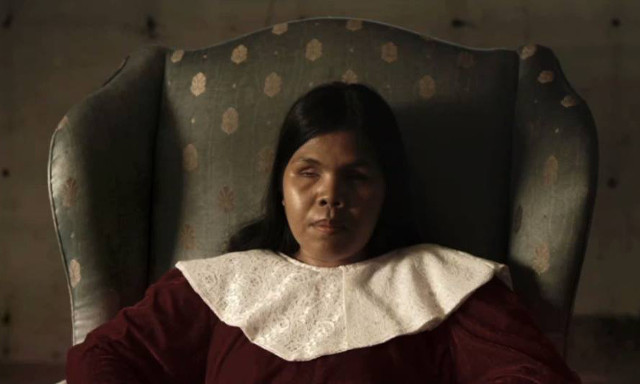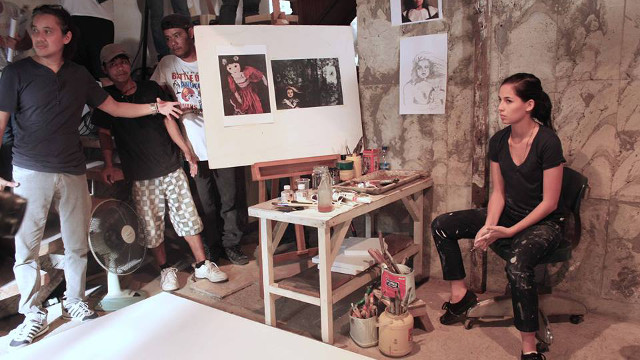SUMMARY
This is AI generated summarization, which may have errors. For context, always refer to the full article.

MANILA, Philippines – The thing most people will likely remember after having seen Mike Alcazaren’s “Puti” – a competing entry at CineFilipino that brought home its share of awards – is how much detail their eyes have drunk in with each scene.
The opening credits, for instance, feature closeup shots of paint ribboning through water, and the colors swirl and thread so precisely that it’s a true treat for the eyes. It’s all the more interesting, then, when you learn that this horror film is acclaimed commercial director Mike Alcazaren’s first full-length feature. On one end, the crispness of each shot belies his knack for prettifying products; on the other, this attention to detail shows a desire to relay profound meaning and significance, for the first time telling a story instead of selling one. And it is this conflict between the director’s skill with mainstream ideas and his desire to create sincere art that runs throughout the film.
Symbolism
“Puti” aims to be clever; in some scenes this works spectacularly, in others it does not. A key example of the latter is the scene where counterfeit painter Amir (Ian Veneracion) washes hands with his son Jaime (Brian Pagala). Amir’s hands are stained red with paint, while his son’s are bloodied from a minor accident. Amir is weighed down by a job that compromises his integrity. His act of washing blood-like red paint from his hands screams symbolism. It’s much too obvious, not to mention clichéd.
In contrast, there are other scenes where Alcazaren manages to pull off subtlety extremely well. In one scene, Amir hires a blind (literally eye-less) female masseuse to dress up in an old-fashioned velveteen dress and sit in the shadows on an old, throne-like chair. This image alone is enough to creep anyone out, but it goes a step further when the masseuse recounts, in a sweet, modulated tone, the harrowing story of how her eyes were gouged out. It’s simple, and it’s scary. It’s this inconsistency that, ultimately, makes Amir’s eventual color-blindness in the film both brilliant and banal.
Again, a lot of times the symbolism is too on-the-nose. Stricken with cerebral achromatopsia after a car accident, Amir starts seeing the world only in black and white. There is a an obvious play with the black-white, good-evil dichotomy here, so it comes as no surprise when Amir only truly realizes that counterfeiting is wrong after the accident. When before he used to thrive in gray areas – committing crimes in order to raise a son he loves fiercely; having Nika, a pretty art school apprentice (Jasmine Curtis-Smith in what is her second venture into independent cinema), help do forgeries in exchange for teaching her the basics – he now clearly sees what is good and what is bad, and commits himself to taking the good path.
READ: ‘Sana Dati,’ ‘Transit’ lead Cinemalaya winners
Fortunately, the scene leading to Amir’s epiphany is the film’s strongest. After being buried alive, Amir manages to scramble upwards and pop his head out from the ground, and discovers himself in an otherworldly place. This shot, with only his head sticking out from the base of a gauzy black-and-white forest, is downright gorgeous – a painting in its own right. Moreover, this dream world is replete with surreal elements: corpses hung from trees, a white horse, a mysterious girl (Lauren Young) swathed in willowy white silk, etc. It is this part of the film that truly sets “Puti” apart from local horror films.
Alcazaren embraces the surreal wholeheartedly here, detaching himself from the norms of his commercial work and just playing with the medium to his heart’s content. This is where the black-and-white concept really sings, and where one is convinced that Alcazaren has skills and a vision lacking in other local directors.

In the end, “Puti” mires itself in its own gray area: 50% of it a bland, mainstream horror film rife with the usual tropes, and the other 50% a sincerely creepy and original effort bursting with clever details (and paying an homage or two to the likes of Hitchcock and Kubrick).
Given that this is Alcazaren’s first attempt at a full-length, fictional film after a considerable career in TV commercials, it is not unusual for him to play it a little too safe. But “Puti” gives many glimpses of an intelligent, creative, and sophisticated director, so it is also not unlikely for one to crave something more from this. Hopefully, Alcazaren’s next ventures will be a better display of how different he can be from everyone else, because he is what the local industry needs: someone who can break the rules beautifully. – Rappler.com
Here’s the film’s trailer (from TV5’s YouTube):
Marguerite de Leon is a social media producer for Rappler, and editor-in-chief of the Filipino Freethinkers’ website.
Add a comment
How does this make you feel?
There are no comments yet. Add your comment to start the conversation.